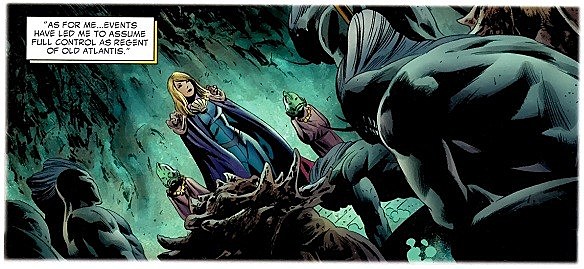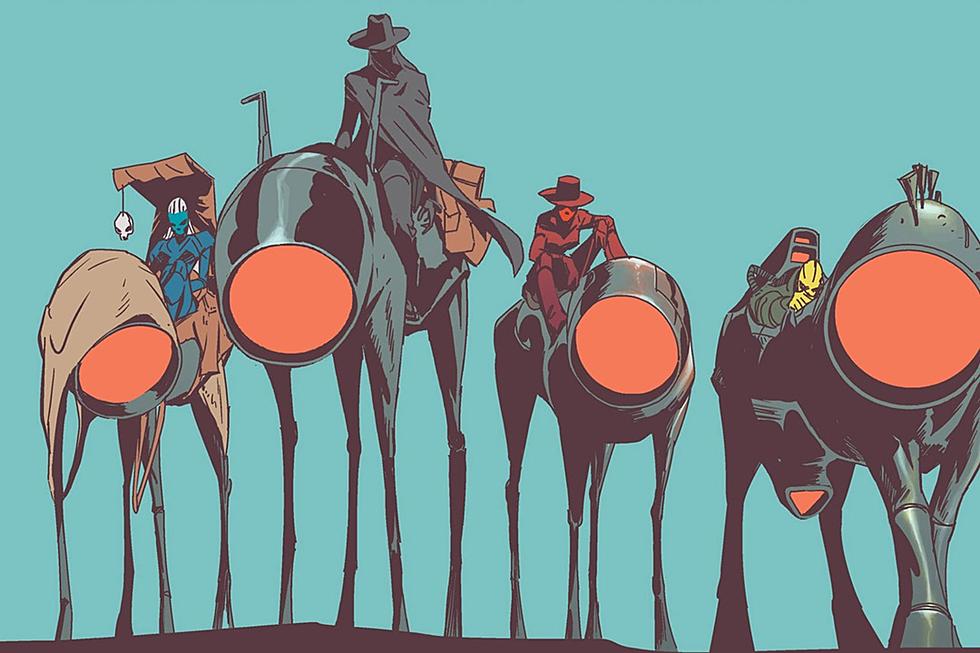
Welcome to the Future Foundation: ‘FF’ #1 Annotation

Yeah, I know we were annotating Hickman's Fantastic Four run from the beginning, but let's just jump ahead, catch up, and get right into the thick of things: Chris Eckert and I annotating comics. This is a big chunk, so get ready -- and features an exclusive question and answer from Jonathan Hickman himself that will continue with each set of annotations!
FF #1 came out this week, a reboot and continuation of the longstanding Marvel franchise by Jonathan Hickman, Steve Epting, Rick Magyar and Paul Mounts. With Johnny Storm deceased, Reed Richards (Mr. Fantastic), Susan Storm-Richards (the Invisible Woman) and Ben Grimm (the Thing) are moving on with their lives, inducting new members like Peter Parker, the Amazing Spider-Man, and a shocking new member who's been carefully set up for inclusion through Hickman's run so far. SPOILERS OBVIOUSLY FOLLOW.In This Issue: One month after the death of Johnny Storm, the Human Torch, the surviving members of the Fantastic Four -- Reed Richards (Mr. Fantastic), Sue Storm (The Invisible Woman) and Ben Grimm (The Thing) -- kick into high gear as the Future Foundation with new uniforms, a new mandate and new members. Reed's father Nathaniel returned from the timestream and Spider-Man invited to join the crew, it's a nice tour of the Baxter Building until there's an alarm at the P.A.V.L.O.V. metahuman facility. After Bentley Wittman, the supervillain known as the Wizard, is broken out by a splinter Advanced Idea Mechanics cell, the Future Foundation return home for dinner. Afterwards, Reed's daughter Valeria and Nathaniel come to warn Reed that they've taken on the responsibility of inducting another new member: Victor Von Doom, the man who hates Reed Richards more than anything else in the world.
[Editor's Note: For the purposes of simplicity, we're shortening the previous title to F4 as opposed to FF to avoid confusion with the new title.]
Page 1: Evoking the first page of Grant Morrison and Frank Quitely's New X-Men #114, the first page of FF both provides an establishing shot and acts as a mission statement for the title's direction with a new beginning. While Hickman's Fantastic Four was hardly at a loss for them, "we have to find some new ideas" acts as a fairly solid thesis statement for the run thus far.
The dudes in the beekeeper outfits are A.I.M. (Advanced Idea Mechanics.) Geek terrorists in a holy war for science. The stuttering Robert Jema is a new character, although he seems realized enough on this page to be used again. The head guy's statement -- "all death leads to rebirth" -- is a clear reference to the relaunch of the title.
This title makes its intended mood clear from the word go, basically.

Chris: A.I.M. provide a nice mirror-image to the Future Foundation: two organizations dedicated to social change and transformative technology, but differing greatly in their methods. First introduced as the R&D branch of HYDRA -- a position they still fill in Hickman's organizational chart from Secret Warriors #1 -- they've since morphed into a freestanding group (or groups) to use when Mad Scientists Tampering with Dangerous Technology are needed. A.I.M. created the Cosmic Cube, M.O.D.O.K., the Super-Adaptoid, the female heroic Scorpion, and assisted the Intelligencia (a group featuring the Wizard!) in transforming Rick Jones, Betty Ross and General Ross into their current Hulky forms. They enjoy tossing "expendables" into experiments -- M.O.D.O.K. was originally a low-level A.I.M. technician -- so I wouldn't be shocked if a weak-willed stutterer like Dr. Jema ends up the group's latest test subject.
 And while most of A.I.M. appear as interchangeable yellow bee-keepers, readers may be interested to know that one of the prime movers behind early experiments like M.O.D.O.K. and the Cosmic Cube was none other than Dr. George Clinton, the Scientist Supreme! Granted, he appeared in shadows and helmets in the original stories, but Peter B. Gillis revealed in Super Villain Team-Up that the Scientist Supreme was also Dr. Funkenstein, or a clean-cut version thereof. And lest you think this was mere coincidence, Gillis introduces Clinton's protege Bernard Worrell in Captain America Annual #7.
And while most of A.I.M. appear as interchangeable yellow bee-keepers, readers may be interested to know that one of the prime movers behind early experiments like M.O.D.O.K. and the Cosmic Cube was none other than Dr. George Clinton, the Scientist Supreme! Granted, he appeared in shadows and helmets in the original stories, but Peter B. Gillis revealed in Super Villain Team-Up that the Scientist Supreme was also Dr. Funkenstein, or a clean-cut version thereof. And lest you think this was mere coincidence, Gillis introduces Clinton's protege Bernard Worrell in Captain America Annual #7.
Sadly, Clinton was kidnapped and tortured by the Red Skull and Adolf Hitler for his knowledge of the Cosmic Cube, despite the best efforts of S.H.I.E.L.D. agent William (Bootsy) Collins to liberate their prisoners. What does this tell us about FF #1? Not a lot, unless Jema and Forson are members of a band I haven't heard. But it does establish that Peter B. Gillis is way funkier than I ever knew, and Worrell and Collins are still at large within the Marvel Universe! Are they part of this new A.I.M.? We'll see.
Pages 2-3: Recap page, likely designed by Hickman himself (that's noticeably the Secret Warriors cover font). The titular "club" is the Future Foundation.
Pages 4-5: This is presumably the hologram of Johnny that was shown to Ben by Thor and Hulk in F4 #588 after their big bout of pugilistic therapy. It's in his recent costume, and I suggest it's intended to have been recorded shortly before his death -- certainly after Reed gave him the gears in F4 #578 for leaving the Negative Zone portal open and asked him what he stood for, since he seems to be referencing that statement.

Pages 6-8: Chris: Spider-Man joining the FF has been a long time coming. How long? Well, Spidey first petitioned to join the club in his second-ever appearance in Amazing Spider-Man #1, released on December 10, 1962. Alongside F4 #12 -- released the same day, and guest-starring the Hulk -- this was the true birth of the "Marvel Universe," showing that the heroes of different books all existed in the same world. Spider-Man's application back in 1962 was rejected because of his shady reputation, not to mention his disgust at learning that being in the FF wasn't a paying gig.
Nearly fifty years later those hurdles have been cleared, and Spidey's an official member! It's fitting this happens in FF #1, given their shared #1 history:
- Their first encounter from ASM #1 was expanded and redrawn by Jack Kirby in 1963's Fantastic Four Annual #1
- When Marvel Team-Up launched in 1972, Spider-Man's teammate for the first three issues was the Human Torch, and Johnny appeared in a record nineteen issues, even stealing top billing from Spidey six times. These stories really solidified the duo's frenemy status on display during the first part of Hickman's run.
- What If...? #1 answered the question "YOUR LETTERS HAVE DEMANDED", What If Spider-Man Joined The Fantastic Four? In case you're wondering, had he joined back in ASM #1, it would have led to Sue feeling like a fifth wheel and shacking up with Namor.
Of course, Spidey and the FF have plenty of other history, succinctly recapped in last year's Spider-Man/Fantastic Four mini-series by Christos Gage and Mario Alberti. That series even has a direct effect on Hickman's run, as it features Kristoff Vernard's first appearance since 1996. When he appeared in F4 #588, he wore the armor that debuted in the mini-series. And yes, commenters, Spider-Man was a member of the "New Fantastic Four" (originally seen in F4 #347-349, and recapped by Gage and Alberti) but that was an ad-hoc team; let him have this moment in FF #1.
Pages 9-10: Susan tells Spidey about Reed's father, Nathaniel Richards. Nathaniel has been around since John Byrne's run on the character, someone who went from having invented the first time travel platform in the Byrne run to the current interpretation of having some kind of innate time travel power. In the continuity of the Hickman titles so far, he left a young Reed in 1951 to join up with one Howard Stark (an alcoholic who faked his own death rather than say goodbye to his son) as an agent of the Shield. With regards to the sliding timescale that implies, it's probably best for us to pretend the years 1961 to 2000 were eaten by a Chronovore.

In any case -- and all of this is from the excellent title S.H.I.E.L.D., available in hardcover soon -- Richards and Stark got into a brouhaha with Nikola Tesla and set off a quantum reaction in his Night Machine, which he stopped from destroying a city underneath Rome by displacing himself, Stark, and Tesla to millions of years in the far future. In Fantastic Four, he states that the accident that sent him to the future (which is unmistakably him with the Night Machine) also drew all of his multiversal selves into the future as well.
The entire affair, according to Richards's narration in F4 #581, really got nasty when Immortus decreed that only one Nathaniel Richards could live, and they all had to kill each other, Highlander style, to figure out which one it'd be. Many of the multiversal Nathaniel Richardses collected artifacts throughout time that were associated with time-travelling conquering supervillain Kang, traditionally a descendent of Nathaniel Richards (and a version of Immortus from earlier in the timestream -- so basically, he was ensuring the events that would lead to his own birth); for more about the rather confusing timeline of this guy, check out our Q&A with Hickman at the bottom for solid answers.
In Nathaniel's personal timeline, at some point after this, he started hanging out with the future versions of Franklin and Valeria. They hatched some kind of plan to "fix" the present, one that involves Franklin reactivating younger Franklin's reality-altering powers before rewriting the future and apparently committing suicide of some kind, but not before kicking Nathaniel out to be with his father. Nathaniel finally appeared in Reed's lab at the end of F4 #588.

Page 11: Sue's Recap Festival continues with a discussion of Old Atlantis. It was introduced in F4 #576, with the "Old Kings of Atlantis" established as living below Lake Vostok in Antarctica. In that first adventure, Sue was named the ambassador between them and the surface, and they were also given two Old Atlantean children to teach as part of their Future Foundation. Namor later claimed that they were parasitic races long banished back in F4 #586, but not before straight-up staking the leader of Old Atlantis with a trident and going all IMPERIUS REX on the place.
As stated here, Susan's currently the regent of Old Atlantic as of F4 #587, due to the fact that she'd taken in the children of their Ul-Uhar (leader) who'd just died, and due to their rites of succession the steward of a leader's children will assume responsibilities upon their death if those children are too young to serve. Meanwhile, those two kids are still part of the Future Foundation, and Sue's ruling Old Atlantis and trying to prevent war with Namor, who continues to regard her as an object of affection.

The final panel is a flashback to the final panel of F4 #587, explained below.
Page 12: Back in F4 #587, Johnny Storm seemingly died in battle against an entire horde of space warlord Annihilus's forces in the Negative Zone. Ben blames himself since Johnny basically sacrificed himself to save him, since Ben was in human form at the time due to a cure the Future Foundation had developed, and moments after the portal closed and he was unable to go back in, he returned to rock form.
Later, using the Ultimate Nullifier as a bargaining chip, Mr. Fantastic attempted to get Johnny or his body back from Annihilus, but all Annihilus could provide was a torn chest symbol from a uniform. (Which doesn't mean he's dead.)

Also, at some point between pages, Franklin altered reality and changed the font.
Page 13: I'm not sure what second-generation unstable molecules were, but it's interesting how the modify-pattern-at-thought black-and-white can-change-between-panels thing reminds me of Rorschach. I don't see it used elsewhere in this issue, but Spidey totally changes from the six to the eight-legged spider design in between panels - which makes me wonder if we'll see more tomfoolery with the look of the uniforms later on.

Presumably the uniforms aren't locked to black and white, so when they inevitably find Johnny, they can go back to the Fantastic Four outfits for a dramatic pose.
Page 14: We first (and last) saw the P.A.V.L.O.V. metahuman psychiatric facility in F4 #579, when Reed went to visit the Wizard as Reed promised after capturing him in F4 #570. He was going on about the inevitability of the end of the world, that God had doomed humanity and that it was all in math, which is very similar to Isaac Newton's "Silent Truth" prophecy from Hickman's S.H.I.E.L.D. title that the world would end in 2060.

Pages 15-19: Largely fight scene, as A.I.M. breaks the Wizard out of P.A.V.L.O.V. Most of Wizard's dialogue builds off of his claims of God bringing on the aforementioned apocalypse. His breakout also gets him nicely back in action for the Intelligencia's upcoming appearance in Avengers #12.1 (the group of evil supergeniuses he was in with Red Ghost, M.O.D.O.K., the Leader and others during World War Hulks).
The "something of mine" that the Wizard vows to reclaim as he leaves is his young clone, introduced all the way back at F4 #570, who's growing at a normal rate and is currently being raised by the Richardses as a member of the Future Foundation as a way of trying to prove that nurture beats nature.

Pages 20-21: The last time we saw the Richards family sit down for a meal, it was back in F4 #571 and was just the core four plus the kids; now, things are a little bit more extensive, with the entire Future Foundation apparently being treated. I do have to wonder if Nathaniel made seafood of some kind for the Old Atlantean kids.
The characters here that we haven't introduced yet are all pointed out in the chart in the backmatter, but for reference, clockwise around the table: Reed, Sue, Spider-Man, Alex Power (oldest of the Power Pack), the Moloids, the Old Atlantis kids, Nathaniel Richards, the Bentley Wittman clone (he calls himself #23), Leech, Dragon Man (who's a robot -- he doesn't even need to eat!), Valeria, Franklin and Ben. Artie's standing behind Reed and just hanging out for some reason.

As for Alex Power's grace, as you can see it reflects the diverse, all-inclusive nature of the people the Fantastic Four take in. It's interesting to note that Franklin and the rest aren't included in any of the subpanels, but I guess it's possible that everyone else there is a believer. Which makes sense, I guess, since they met Him and He was Jack Kirby back in Mark Waid and Mike Wieringo's masterful F4 #511.
With regards to everyone else, the Ancient Ones are presumably the gods of the Old Atlantean kids, Val and Dragon Man (an android created by Diablo who's been upgraded) are atheists, and Bentley (the clone of the Wizard from the last scene) is, well, a Satanist.
As for the Moloids, they're super-evolved children from the City of the High Evolutionary, which was an abandoned underground city with an evolution engine that got populated by some Moloids. While the Moloids who went there became human-looking, their children stayed Moloid in appearance, so they basically abused and exiled them until the FF took them in right before the High Evolutionary's city rose to the surface. This was all back in F4 #575. So the machine that they're praying to is the one that created the "evolving effect" around the city.
Chris: Though it was a common assumption, Karl Kesel and Stuart Immonen confirmed Ben Grimm's Judaism in F4 v3 #56. The other three core members all had non-denominational Christian weddings, but have otherwise never appeared to be that religious, though Susan was one of the "believers" recruited by The Goddess in Infinity Crusade. Johnny describes her as "religious, in a quiet sort of way," which is apparently more than the rest of the team, who are left behind. Have we forgotten any hot-button Religious Fantastic Four stories?

Pages 22-23: The Inhumans that Reed brings up at dinner were, at their introduction, a group of people on Earth who had been experimented on by the alien Kree. At around puberty, they would use the "Terrigen Mists" to transform and become their "Inhuman" self, which usually had some kind of badass superpower. At this point they've gone into space to take over Hala, the Kree homeworld, but back in F4 #577 Hickman established that the Kree had actually performed this experimentation on four other cultures in the galaxy, and now they're all living on a city on the moon, waiting for the lost King of the Inhumans, Black Bolt, who fell into an interuniversal Fault at the end of Dan Abnett, Andy Lanning and Paul Pelletier's War of Kings event.
The "four cities" -- the Inhuman City, the High Evolutionary's, Old Atlantis and the Negative Zone (where Johnny died and Annihilus rules) -- are fated to be in a war according to a prophecy the future version of Franklin told Valeria back in F4 #574. That prophecy also establishes that they will need the assistance of Doctor Doom, something that will come up later in this issue. Since the Universal Inhumans are waiting for Black Bolt to claim the Earth, Reed's understandably keen on terraforming them somewhere else to live.
As for Nathaniel's resistance to terraforming the moon, I'm not sure if that's just him being a dick at the dinner table or if it has to do with the big broken, non-terraformed moon he saw in the future (a detail that's shared with John Byrne's interpretation of Nathaniel's origin).

Page 24: The interaction between Franklin and Reed, where Reed tells Franklin how to find the pattern in a videogame (something that would come instinctually to a problem-solver like Artie), seems like it's setting up something Franklin's going to need to survive later -- perhaps against the supervillain Arcade.

Also, as far as Chris and I can tell, this is the first time Artie's ever managed to make decipherable sounds with his vocal chords -- in other words, he's learning to talk, as opposed to using his psychic projection helmet (apparently now a disc on his forehead) that recreates his lost mutant power of... psychic projection.

Pages 25-27: Doom's been inducted into the Future Foundation at Valeria's behest, who's doing it at the future Franklin Richards's behest, who's doing it at the behest of the future Valeria. Basically, they know the future, and they feel that Doom will be required to overcome whatever obstacles are coming. Doom's maintained a complicated relationship with the Fantastic Four forever -- sometimes archenemies, sometimes reluctant allies -- and this would seem to go into the latter camp, albeit to a more extreme degree than before. Still, Reed's got at least two time-travelers telling him this is the play to make, so he's willing to go for it.
Chris: "Uncle Doom" may not be a blood relation to Valeria -- at least this Valeria isn't, though that's for another batch of annotations -- but he is her godfather, having midwived Sue through a difficult cosmic-ray-complication-filled birth. As a result, he demanded she be named after his first love, declared himself her godfather, and promised never to harm her. He's kept his word, though he did use her as a "familiar" in Mark Waid and Mike Wieringo's "Unthinkable" arc, where he controlled her as a pawn against her family. Still, he never harmed Valeria herself, and even mused at the prospect of raising her "properly," as his own daughter. Given some of her recent decisions -- the alliance with Doom, the plan to kill Annihilus (to revenge Johnny, as seen last issue in F4 #588) -- her uncle may have already rubbed off on her.

Backmatter: I have no idea if it's notable or not, but it seems weird that Nathaniel and Doom are missing from the Future Foundation roll call. Maybe they're just too old.
The Speculation Peanut Gallery
Every week, Marvel has granted us a boon: we can ask Marvel Architect and FF writer Jonathan Hickman exactly one question. Curious about what's going on with Nathaniel Richards, Kang, and the previous appearances of Nathaniel in the Marvel Universe? Well, we were too.
ComicsAlliance: Jonathan, during the Great Hunt you had various of the Nathaniels mention they built Chronopolis and formed the Anachronauts, both achievements of Kang's - not to mention the giant Rama-Tut sphinx head in the future we saw in S.H.I.E.L.D. Kang's traditionally been Nathaniel Richards's distant grandson, especially as recently reinforced in Allan Heinberg's Young Avengers with the character of Iron Lad, but how much should we read into the idea that they might be one and the same?"
Jonathan Hickman: Well, this is one of those things where it gets a bit loopy, not just from the time-jumping nature of the years of existing stories, but also from the infinite number of variables I introduced (by dumping every Nathaniel in the Multiverse into the 616 universe).
So, here's how the atemporal situation breaks down in my mind:
The Nathaniel Richards from S.H.I.E.L.D., and the Nathaniel Richards from my first issue (FF#570) is OUR (read NATIVE to the 616) Nathaniel. While the Byrne and Defalco version (not a victor of the Great Hunt and now dead as of FF#582) was not, he was, for a time, the most active Nathaniel in the normal Marvel Universe (as our Nathaniel was busy rewriting the future and OTHER THINGS).
All of this will become a bit more delineated when we meet (Bryne/Defalco) Nathaniel's Reed at a later date. As for your primary question regarding Kang, yes, he is a distant grandson of a Nathaniel Richards -- not ours... but the BEAST Nathaniel.I probably should make a diagram of all this at some point. Hope that answers your question.
Alright, guys. Join us next month for FF #2.
More From ComicsAlliance









